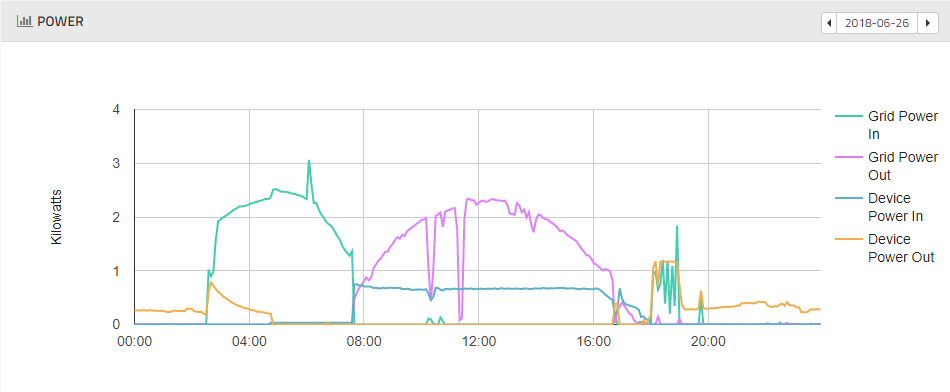Summer is definitely upon us now as we enjoy the glorious summer weather. Disappointing weather earlier in 2018 has given way to two record months in May and June which yielded the highest monthly outputs for their respective months since the system was installed back in 2015. Some days we buy no measurable electricity or gas (given that the electricity meter has a resolution of 1 kWh) depending on what the need to charge the car. If the car is at home then I can fully charge it from the solar panels, whereas if the car is at away from home during the day then I may need to give it some charge overnight. When charging overnight I have been tending to charge for the minimum number of hours up to 7:30 AM when I typically leave home on a weekday – that pattern provides for mostly Economy 7 Energy from the grid less whatever comes off the solar panels from the rising sun less whatever might be left in the PowerVault from the previous day as illustrated below:
The green ‘hill’ from around 3:30 to 7:30 AM is created by car charging. Normally this would be seen as a rectangular block as the car charger effectively runs at a constant 10 Amps (2.3 kW) through the operating period. However in the illustration the charging event (at least in terms of power drawn from the grid) seems rounded at both the beginning and the end. At the beginning of the car charging period the mustard ‘Device Power Out’ curve shows the last remaining stored energy from yesterday being drawn from the PowerVault, while at the end of the charging period the ramp down is a result of increasing output from the solar panels reducing the need for power from the grid. Hence at the moment the car charging ends there’s a sudden switch to charging the PowerVault at full power (the blue line) and some surplus power not used by the PowerVault (the purple line) – suggesting that something around 1 kW is suddenly available. Although the purple line is described as ‘Grid Power Out’ that’s not strictly true here as much of that surplus is being diverted to make hot water (although this is invisible to the PowerVault).
After that digression, my actual purpose in making this post was to reflect upon relative energy costs and the best use of my solar power to reduce energy cost.
| Energy usage | Petrol | Daytime Electricity | Nighttime Electricity | Gas | Solar Electricity |
|---|---|---|---|---|---|
| Battery Storage | n/a | n/a - no economic case to charge battery from grid during day | Optional - need to consider value of saved energy versus cost of 1 cycle of battery cycle-life | n/a | Self-use Priority #1 via PowerVault (daytime electricity -> solar) |
| Car Charging | Manual 3rd backup (typically only used for long journeys when charging en-route becomes impractical) | Manual 2nd back-up | Automated 1st backup | n/a | Self-use Priority #2 via ImmerSUN (nighttime electricity -> solar) |
| Water Heating | n/a | Manual 3rd backup (never used in 3 years) | Manual 2nd backup (never used in 3 years) | Automated 1st backup for dull days | Self-use Priority #3 via ImmerSUN (gas to solar) |
| Space Heating | n/a | Manual backup | Manual backup | Default | n/a - a summer solar surplus is a poor match to winter heating demand but could be Priority #4 |
The table above shows columns of energy sources ordered by reverse energy cost versus the major energy consumers in the house: battery storage, car charging, space heating and water heating. Energy consumers are ranked according to the value of displacing the the alternative energy course if not solar:
- Battery storage – I currently only charge the battery storage from solar, although there would be a seasonal economic argument to charge from cheap rate electricity if the differential between day and night rates was higher.
- Car charging – I generally charge on cheap night-rate electricity when I don’t have enough solar. In summer I program my car charger via the ImmerSUN’s 7-day timer to deliver sufficient charge for the day ahead, but sufficient headroom to make use of any available solar.
- Water heating – water heating is my 3rd priority for solar self-use and is automatically based up by the gas boiler which runs for an hour making hot water in the early evening if the tank isn’t already hot from diverted solar power during the day. The gas thermostat is also set slightly colder than the immersion heater – still very usable for a bath or shower from gas but giving some ability to delay water heating from a dull day to a following sunny day.
- Space heating – my space heating is generally gas. It would be possible to run a heater (or heaters) such as storage radiators via the ImmerSUN’s third output, but I consider that the cost of the heater(s) and installation is unlikely to be recouped given the major mismatch between surplus solar generally being in summer and heat demand being in winter.
